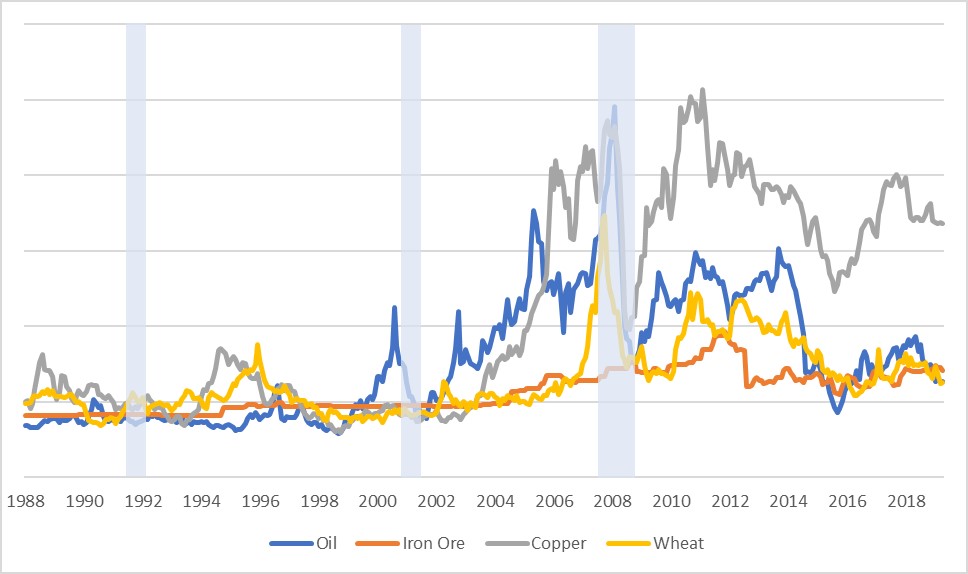CONTACT US
Do you have any further questions? How can we help you? Get in touch with us.
Twenty years ago, if you were discussing today’s historically low unemployment rate, record pace of lending, and 3% worldwide economic growth, you would assume that commodity prices were roaring worldwide. In examining the past three recessions, the price of each commodity spiked before a recession, then dropped precipitously immediately before and during the recession. In this article, William Snyder explores commodities and the role they play in predicting recessions.
Twenty years ago, if you were discussing today’s historically low unemployment rate, record pace of lending, and 3% worldwide economic growth, you would assume that commodity prices were roaring worldwide. However, copper prices currently sit at $2.60[1], wheat at $4.90, iron ore at $93, and WTI oil at $53, all of which are at relatively low levels for their respective industries, and which are notable considering the instability in the Middle East and the consumption of commodities in China.
In examining the past three recessions, as shown in the graph below, the price of each commodity spiked before a recession, then dropped precipitously immediately before and during the recession. Today, there are warning signs globally that could signify a downturn in the world economy: instability in the European Union, inverted yield curves, and a softening of both manufacturing and consumer indexes. If commodity prices took a dive as in previous recessions, it would signify turmoil for colonial economies that extract materials from the ground such as those in South America, Canada, Australia, Russia, and the Middle East.
In 2016, a commodity downturn occurred similar to those of the previous recessions, but a recession ultimately never materialized: the European Union was plowing money into its economy, China held its economy steady, and the U.S. economy continued trending upward. Today, the economies of both Germany and Italy are in recession and China is embroiled in a trade war with the United States. The global demand for copper, auto parts, and machinery from China could indicate a future slowdown in manufacturing as China represents a large proportion of global demand.[2]
Commodities are also affected by the tariffs hitting several U.S. corporations.[3] CR3 Partner, Jeff Armstrong, witnessed the damage. “One of our clients produced auto parts from stainless steel imported from China, on which the government levied a 25% tariff in 2018,” said Jeff. “Our client was unable to pass the entire cost to customers due to management timidity and strong resistance from its Tier 2 auto customers. As a result, the company was liquidated and many of the company’s products are no longer produced in the U.S.”
CR3 Partner, Barak Tulin, has witnessed secondary effects of tariffs that affect industries beyond those that are directly tariffed. “You might assume that companies in the marketing services industry would not be affected by tariffs: their primary input costs are labor-related, and very few of their non-labor expenses are subject to tariffs. However, this ignores the potential revenue impact of tariffs. One of our clients experienced a significant decline in revenue after a key customer abruptly reduced its marketing budget. The customer, which manufactures food products and therefore has significant exposure to agricultural input costs, claimed that in order to mitigate the projected impact of agricultural tariffs, it would reduce its discretionary SG&A expenses, including marketing programs, as a preemptive measure.”
Money is plentiful and corporations are on a borrowing spree, similar to what we witnessed in 2006, and The Great Recession followed two years later. These warning signs suggest that, if a recession does take place in the next 12 to 18 months, the slowing global economy could affect the U.S. economy, rather than the reverse.[4] Companies that survived previous recessions are cautious and are watching for such warning signs after being upended by money center bank policies. When intuition fails, one must rely on secondary data of the commodities to help predict the upcoming recession. If and when the next recession hits, it will most likely be led by a collapse in global commodity pricing beyond the historic low prices we’re seeing today.

Shaded areas indicate U.S. recessions.
U.S. Bureau of Labor Statistics, Producer Price Index by Industry, retrieved from FRED,
Federal Reserve Bank of St. Louis; https://fred.stlouisfed.org/.
CR3 Partners, LLC is a national turnaround and performance improvement firm that assists, guides and collaborates with management teams and their constituents facing any sort of transition, stress or distress. William Snyder is a Partner in CR3’s Dallas office. Jeff Armstrong, a Partner in CR3’s Atlanta office, and Barak Tulin, a Partner in CR3’s New York office, contributed additional research for this article.
[1] Investing.com: https://www.investing.com/analysis/has-dr-copper-been-screaming-about-a-recession-that-only-few-heard-200469792
[2] The Wall Street Journal: https://www.wsj.com/articles/copper-prices-fall-on-weak-manufacturing-data-11569952942
[3] The Wall Street Journal: https://www.wsj.com/articles/for-a-change-its-the-world-that-is-pulling-down-the-u-s-economy-11570021741
[4] Bloomberg Businessweek: https://www.bloomberg.com/news/articles/2019-10-08/new-kind-of-recession-threat-presents-problem-for-powell-and-fed
Do you have any further questions? How can we help you? Get in touch with us.